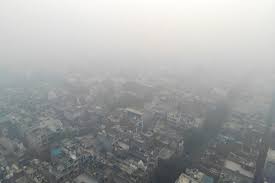
Delhi’s air pollution reached hazardous levels on November 15, as the National Capital Region (NCR) was engulfed in a thick layer of toxic smog, leading to an alarming deterioration in air quality. Drone footage shared by news agency ANI, filmed around 9:30 am from the Anand Vihar area, vividly captured the extent of the city’s ongoing pollution crisis, showing a dense haze enveloping the region.
The footage, which has gone viral on social media, revealed the extent to which smog had blanketed several parts of Delhi and its surrounding areas, including Noida, Ghaziabad, and Gurugram. The dramatic visuals underscored the severity of the situation, as residents continued to suffer from the harmful effects of poor air quality.
AQI Reaches Hazardous Levels
As per data from Swiss air technology company IQAir, Delhi’s Air Quality Index (AQI) surged to hazardous levels, with some areas reporting alarming AQI readings between 800 and 1,100. Anand Vihar recorded an AQI of 1,105, Dwarka-Sector 8 reported 1,057, and Vasant Vihar’s Block C reached 1,041. These figures place these areas in the “severe” category, posing serious health risks for residents.
The Central Pollution Control Board’s (CPCB) Sameer app also indicated a concerning AQI of 413 for Delhi, categorizing the air as “severe.” Multiple areas across the city reported AQI levels between 401 and 500, reflecting the hazardous impact of the pollution on the public’s health.
GRAP Stage III Restrictions Imposed
In response to the deteriorating air quality, the Graded Response Action Plan (GRAP) Stage III restrictions were implemented on Friday. These measures are designed to address severe air pollution in Delhi and its neighboring regions. The Stage III restrictions include a ban on non-essential construction and demolition activities, closure of stone crushers, and the prohibition of BS-III petrol and BS-IV diesel vehicles. The restrictions aim to reduce the concentration of particulate matter and limit the sources contributing to the pollution.
If the situation escalates to Stage IV, more stringent measures will be enforced. These include a ban on inter-state buses (except electric and CNG-powered vehicles), the suspension of mining activities, a shift to online classes for younger students, and daily water sprinkling on major roads to reduce dust pollution.
Impact on Public Health
With the air quality in Delhi reaching hazardous levels, health experts have raised concerns about the long-term impact on public health. Prolonged exposure to such polluted air can lead to respiratory issues, cardiovascular problems, and aggravate pre-existing conditions such as asthma. Authorities are urging residents, especially children, the elderly, and those with respiratory conditions, to limit outdoor activities and take preventive measures.
The alarming rise in Delhi’s pollution levels has once again highlighted the need for more stringent measures to address the city’s air quality crisis. Despite various efforts to curb pollution, the annual worsening of air quality during the winter months remains a significant challenge for the government and residents alike.
Sources By Agencies




